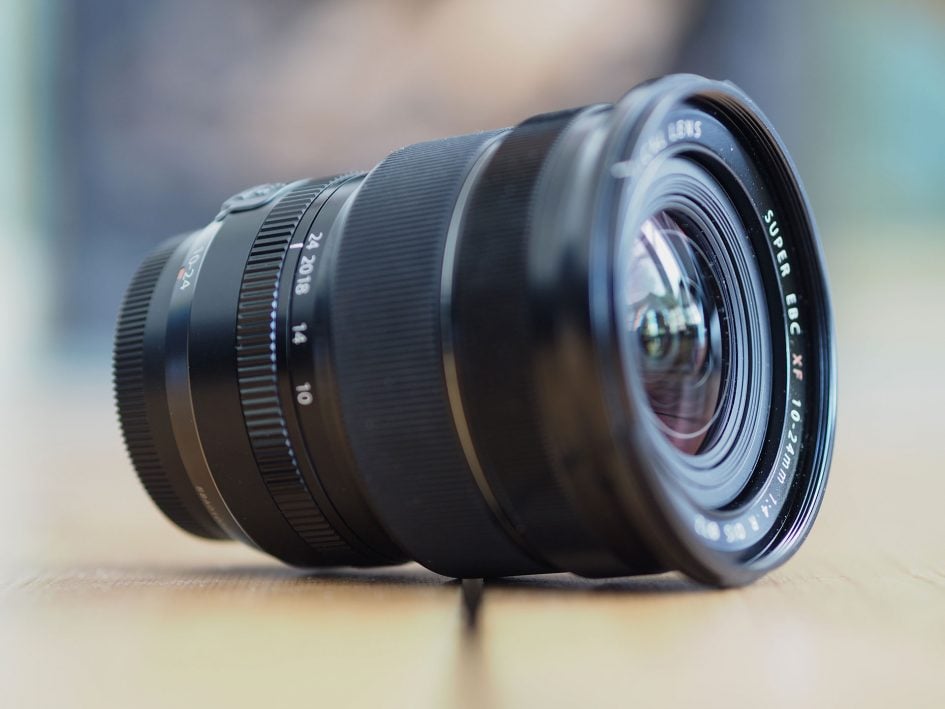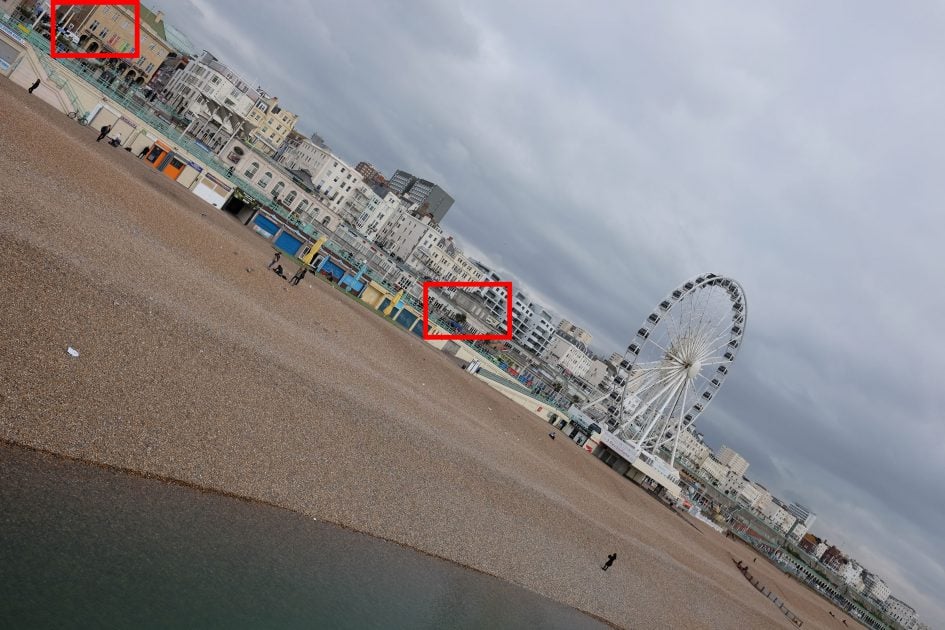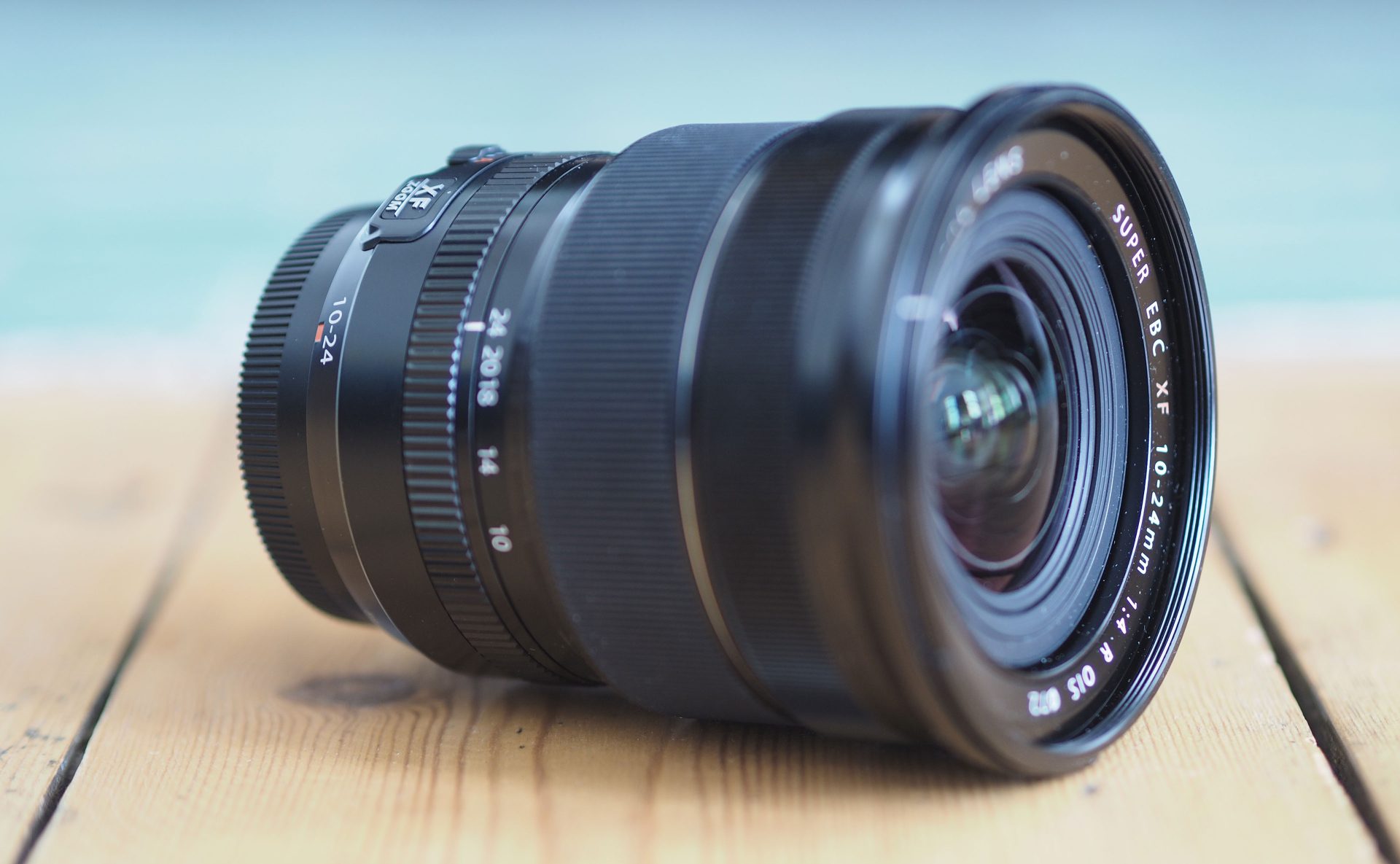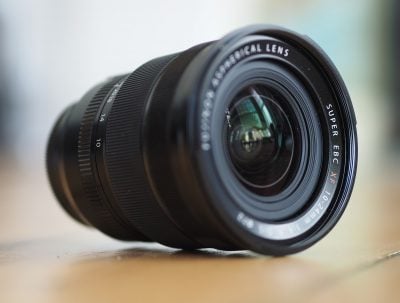Fujifilm XF 10-24mm f4 review-so-far
-
-
Written by Gordon Laing
Intro
Fujifilm’s XF 10-24mm f4 is an ultra-wide zoom for its X-mount mirrorless cameras. Announced in December 2013, it delivers a 15-36mm equivalent range with a constant f4 focal ratio that’s ideal for capturing expansive landscapes, large architecture, or simply big group shots when you can’t step back any further. There’s no weather sealing, but the optical stabilisation is useful for handheld and video work even at these short focal lengths.
The optical design employs 14 elements in 10 groups, with four aspherical and four extra low dispersion elements. The focal ratio is a constant f4 throughout the range and the aperture system uses seven rounded blades. There’s optical stabilisation built-in, and the closest focusing distance of 24cm allows a maximum magnification of 0.16x. The barrel measures 78mm in diameter, 87mm in length, weighs 410g and offers a 72mm filter thread. As noted above, there’s no weather sealing on this model.
As a fan of ultra-wide photography, I’ve been an owner of the XF 10-24mm f4 since its launch and have been delighted with its results, especially at the wide-end. If you use filters, especially stacked NDs, you’ll need to beware of possible vignetting at the widest focal lengths; I use it with the Lee Seven5 ND system and find I need to nudge the zoom ring to around 12mm to avoid vignetting completely, but that’s still very wide and saves me from using larger and more expensive 100mm systems. For a while, the XF 10-24mm was the only ultra-wide zoom from Fujifilm, making it a no-brainer for anyone needing this coverage, but the company recently announced an XF 8-16mm f2.8 R LM WR for release sometime in 2018. It sports wider coverage, a brighter focal ratio and weather-sealing, but its price will be higher, its on-sale date unconfirmed, and there’s no news on how it’ll handle filters. As such, the XF 10-24mm f4 remains a highly recommended option – check out my review-in-progress!


Above left: Fuji XF 10-24mm at 10mm (15mm equiv), above right: Fuji XF 10-24mm at 24mm (36mm equiv)
Check prices on the Fujifilm XF 10-24mm f4 at Amazon, B&H, Adorama, or Wex. Alternatively get yourself a copy of my In Camera book or treat me to a coffee! Thanks!

For my lens tests on other systems I normally shoot in RAW and process the files with corrections disabled to see what’s happening behind the scenes. But the more I shoot with the Fuji X system, the more I appreciate the out-of-camera JPEG performance, especially when using Lens Modulation Optimisation (LMO) with Fujinon lenses. I’ve also found few RAW converters which can do justice to the X-Trans sensor. So in line with my other XF lens tests, I’m going to present crops from unaltered out-of-camera JPEGs here (with LMO enabled as default) as I believe they show the lens in the best light. I did of course also shoot the scene in RAW and if I find a workflow which delivers good results in the future I’ll update this review with RAW comparisons as well.
I believe many X series owners who are interested in the XF 10-24mm f4 will be weighing it up against the XF 16mm f1.4, either as potential owners or existing ones. So in my first two tables below I’ve compared the sharpness of both lenses on the same view in the corner and centre of the image; I shot with the XF 16mm f1.4 first, then matched the field of view on the XF 10-24mm afterwards.
Since the XF 10-24mm has a maximum aperture of f4, the first three rows on each table show an expanded crop from the XF 16mm f1.4 at f1.4, f2 and f2.8. As you can see in the first table, the XF 16mm f1.4 performs very well in the corners even when wide-open at f1.4. As you close the aperture, you’ll see a lightening in the corners, revealing the inevitable presence of vignetting, although it’s fairly mild and essentially gone by f2.8.
At f4 we can start to compare it against the XF 10-24mm, which looks quite soft in the corners in comparison. The XF 10-24mm only becomes crisp in the corners when closed to around f8, while the XF 16mm f1.4 arguably peaks between f5.6 and f8. Thanks to LMO, both lenses continue to look crisp at f11, although some softness due to diffraction is kicking-in at f16.

Above: Fuji XF 16mm f1.4 at f1.4. 100% crop from corner of JPEG

Above: Fuji XF 16mm f1.4 at f2. 100% crop from corner of JPEG

Above: Fuji XF 16mm f1.4 at f2.8. 100% crop from corner of JPEG

Above left: Fuji XF 16mm f1.4 at f4, above right: Fuji XF 10-24mm at 16mm f4. 100% crops from corner of JPEGs

Above left: Fuji XF 16mm f1.4 at f5.6, above right: Fuji XF 10-24mm at 16mm f5.6. 100% crops from corner of JPEGs

Above left: Fuji XF 16mm f1.4 at f8, above right: Fuji XF 10-24mm at 16mm f8. 100% crops from corner of JPEGs

Above left: Fuji XF 16mm f1.4 at f11, above right: Fuji XF 10-24mm at 16mm f11. 100% crops from corner of JPEGs

Above left: Fuji XF 16mm f1.4 at f16, above right: Fuji XF 10-24mm at 16mm f16. 100% crops from corner of JPEGs
Scroll down to see how they compare in the middle of the frame, or skip to my Fujifilm XF 10-24mm sample images.
Fujifilm XF 10-24mm centre quality
In the table below I’ve once again started with the XF 16mm f1.4 at f1.4, f2 and f2.8. The crops in this table are taken from the exact same images as those for the corner results above, and interestingly the centre looks a little lacking in definition at the larger apertures. It improves by f2.8 though, becomes better still at f4 and arguably peaks between f5.6 and f8.
At f4 we can again compare the performance with the XF 10-24mm which interestingly comes out of the gate looking very strong in the centre. The Sun had come out a little more at this point, so the XF 10-24mm crops are a little brighter, but there’s definitely greater crispness to them at f4 in the middle. Between f5.6 and f8, both lenses essentially deliver the same detail.
So I’d say the XF 16mm delivers more consistent sharpness across the frame at each aperture, whereas the XF 10-24mm may be impressively sharp in the middle, but is soft in the corners when the aperture is wide-open. But by the time both lenses are closed to f8, they’re delivering similar degrees of detail across the frame at the 16mm focal length. So I’d only recommend the XF 16mm over the XF 10-24mm at 16mm – in terms of sharpness at infinity – if you’re likely to shoot at larger apertures. My example here may not have looked amazing in the middle of the frame at large apertures, but I shot other distant subjects which looked very respectable at f1.4.

Above: Fuji XF 16mm f1.4 at f1.4. 100% crop from centre of JPEG

Above: Fuji XF 16mm f1.4 at f2. 100% crop from centre of JPEG

Above: Fuji XF 16mm f1.4 at f2.8. 100% crop from centre of JPEG

Above left: Fuji XF 16mm f1.4 at f4, above right: Fuji XF 10-24mm at 16mm f4. 100% crops from centre of JPEGs

Above left: Fuji XF 16mm f1.4 at f5.6, above right: Fuji XF 10-24mm at 16mm f5.6. 100% crops from centre of JPEGs

Above left: Fuji XF 16mm f1.4 at f8, above right: Fuji XF 10-24mm at 16mm f8. 100% crops from centre of JPEGs

Above left: Fuji XF 16mm f1.4 at f11, above right: Fuji XF 10-24mm at 16mm f11. 100% crops from centre of JPEGs

Above left: Fuji XF 16mm f1.4 at f16, above right: Fuji XF 10-24mm at 16mm f16. 100% crops from centre of JPEGs
More results to follow!

 Fujifilm's XF 10-24mm f4 is an ultra-wide zoom for its X-mount mirrorless cameras upon which it delivers a 15-36mm equivalent range that's ideal for capturing expansive landscapes, large architecture, or simply big group shots when you can't step back any further. The optical quality is very good, especially at the wide-end where you want it, and while there's sadly no weather sealing, the optical stabilisation is useful for handheld and video work even at these short focal lengths. If you're using small filter systems, like the Lee Seven5 NDs, beware that vignetting will occur at the shortest focal lengths, but normally disappears by 12mm. Also note Fujifilm recently announced an XF 8-16mm f2.8 for sometime in 2018 with wider coverage, a brighter aperture and weather sealing, but the price, release date and filter compatibility are unknown. Even with this new lens in the wings, I can still Highly Recommend the XF 10-24mm f4 - it's one of my most used personal lenses.
Fujifilm's XF 10-24mm f4 is an ultra-wide zoom for its X-mount mirrorless cameras upon which it delivers a 15-36mm equivalent range that's ideal for capturing expansive landscapes, large architecture, or simply big group shots when you can't step back any further. The optical quality is very good, especially at the wide-end where you want it, and while there's sadly no weather sealing, the optical stabilisation is useful for handheld and video work even at these short focal lengths. If you're using small filter systems, like the Lee Seven5 NDs, beware that vignetting will occur at the shortest focal lengths, but normally disappears by 12mm. Also note Fujifilm recently announced an XF 8-16mm f2.8 for sometime in 2018 with wider coverage, a brighter aperture and weather sealing, but the price, release date and filter compatibility are unknown. Even with this new lens in the wings, I can still Highly Recommend the XF 10-24mm f4 - it's one of my most used personal lenses.



